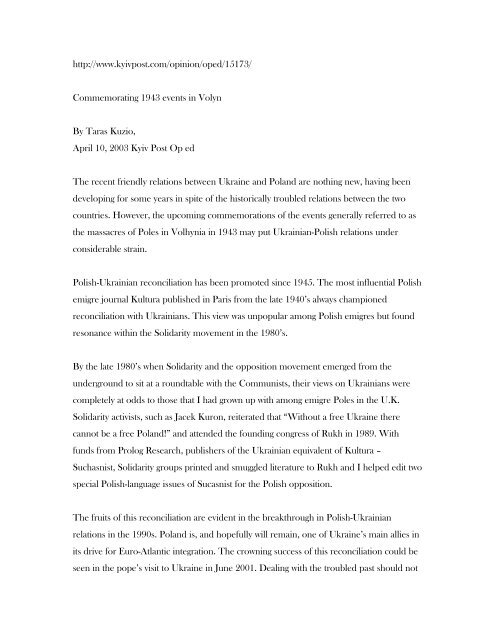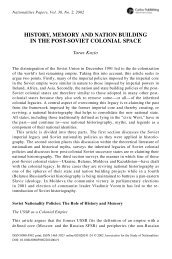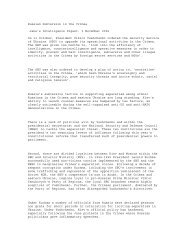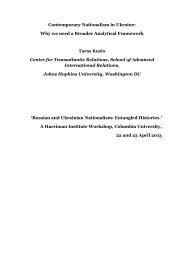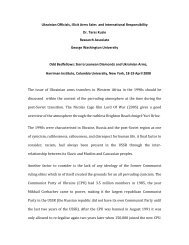'Commemorating 1943 events in Volyn', Kyiv Post, 10 ... - Taras Kuzio
'Commemorating 1943 events in Volyn', Kyiv Post, 10 ... - Taras Kuzio
'Commemorating 1943 events in Volyn', Kyiv Post, 10 ... - Taras Kuzio
Create successful ePaper yourself
Turn your PDF publications into a flip-book with our unique Google optimized e-Paper software.
http://www.kyivpost.com/op<strong>in</strong>ion/oped/15173/<br />
Commemorat<strong>in</strong>g <strong>1943</strong> <strong>events</strong> <strong>in</strong> Volyn<br />
By <strong>Taras</strong> <strong>Kuzio</strong>,<br />
April <strong>10</strong>, 2003 <strong>Kyiv</strong> <strong>Post</strong> Op ed<br />
The recent friendly relations between Ukra<strong>in</strong>e and Poland are noth<strong>in</strong>g new, hav<strong>in</strong>g been<br />
develop<strong>in</strong>g for some years <strong>in</strong> spite of the historically troubled relations between the two<br />
countries. However, the upcom<strong>in</strong>g commemorations of the <strong>events</strong> generally referred to as<br />
the massacres of Poles <strong>in</strong> Volhynia <strong>in</strong> <strong>1943</strong> may put Ukra<strong>in</strong>ian-Polish relations under<br />
considerable stra<strong>in</strong>.<br />
Polish-Ukra<strong>in</strong>ian reconciliation has been promoted s<strong>in</strong>ce 1945. The most <strong>in</strong>fluential Polish<br />
emigre journal Kultura published <strong>in</strong> Paris from the late 1940’s always championed<br />
reconciliation with Ukra<strong>in</strong>ians. This view was unpopular among Polish emigres but found<br />
resonance with<strong>in</strong> the Solidarity movement <strong>in</strong> the 1980’s.<br />
By the late 1980’s when Solidarity and the opposition movement emerged from the<br />
underground to sit at a roundtable with the Communists, their views on Ukra<strong>in</strong>ians were<br />
completely at odds to those that I had grown up with among emigre Poles <strong>in</strong> the U.K.<br />
Solidarity activists, such as Jacek Kuron, reiterated that “Without a free Ukra<strong>in</strong>e there<br />
cannot be a free Poland!” and attended the found<strong>in</strong>g congress of Rukh <strong>in</strong> 1989. With<br />
funds from Prolog Research, publishers of the Ukra<strong>in</strong>ian equivalent of Kultura –<br />
Suchasnist, Solidarity groups pr<strong>in</strong>ted and smuggled literature to Rukh and I helped edit two<br />
special Polish-language issues of Sucasnist for the Polish opposition.<br />
The fruits of this reconciliation are evident <strong>in</strong> the breakthrough <strong>in</strong> Polish-Ukra<strong>in</strong>ian<br />
relations <strong>in</strong> the 1990s. Poland is, and hopefully will rema<strong>in</strong>, one of Ukra<strong>in</strong>e’s ma<strong>in</strong> allies <strong>in</strong><br />
its drive for Euro-Atlantic <strong>in</strong>tegration. The crown<strong>in</strong>g success of this reconciliation could be<br />
seen <strong>in</strong> the pope’s visit to Ukra<strong>in</strong>e <strong>in</strong> June 2001. Deal<strong>in</strong>g with the troubled past should not
harm this tremendous progress, which is decades ahead that of the “normalization” of<br />
Ukra<strong>in</strong>ian-Russian relations.<br />
<br />
Plac<strong>in</strong>g the Volhynia massacres <strong>in</strong> context<br />
Polish-Ukra<strong>in</strong>ian reconciliation is well developed at the elite levels only. Polish op<strong>in</strong>ion<br />
polls regularly f<strong>in</strong>d that the public image of Ukra<strong>in</strong>ians is very low and a recent poll found<br />
that only Romanians and Gypsies have more negative stereotypes. A Ukra<strong>in</strong>ian shuttle<br />
trader to Poland recently told Reuters that at the border Ukra<strong>in</strong>ians are treated terribly.<br />
“There’s one (Polish) shift that’s terrible...they call Ukra<strong>in</strong>ians pigs, or say ‘get out of here,<br />
you st<strong>in</strong>k.’ As Professor Piotr Wrobel, chair of Polish History at the University of Toronto,<br />
confessed to me, its f<strong>in</strong>e for his fellow Polish academics to be “anti-Ukra<strong>in</strong>ian” but not<br />
“anti-Semitic.” Nevertheless, 300,000 Ukra<strong>in</strong>ians are work<strong>in</strong>g <strong>in</strong>side Poland.<br />
Historians, writers, religious leaders and political parties have nourished the Polish negative<br />
stereotype of Ukra<strong>in</strong>ians for more than a century. This was even the case <strong>in</strong> Communist<br />
Poland when criticism of Russians was not permitted. However, at the same time the<br />
Communist authorities published countless books with mass circulation, films, and even<br />
school <strong>in</strong>structional materials that <strong>in</strong>culcated a stereotype of genocidal anti-Polish<br />
Ukra<strong>in</strong>ians. Such views were also common <strong>in</strong> Polish Diaspora newspapers.<br />
Books and other media articles propagat<strong>in</strong>g these stereotypes about Ukra<strong>in</strong>ians did not<br />
suddenly cease after the Communists left office. This would have been difficult as these<br />
stereotypes had grown deep roots <strong>in</strong> Polish society and former Communists, such as<br />
President Alexander Kwasniewski, were <strong>in</strong> power. Only Gazeta Wyborcza, edited by<br />
Kuron’s Solidarity ally Adam Michnik, is critical of the plans for the <strong>1943</strong><br />
commemoration.
Sadly therefore, the planned commemoration of the Volhynia massacres takes the entire<br />
subject out of context. Ukra<strong>in</strong>ian-Polish relations were poor a long time prior to <strong>1943</strong>.<br />
Polish repression of Ukra<strong>in</strong>ians and other m<strong>in</strong>orities <strong>in</strong> the 1930s led to the rise of extreme<br />
right-w<strong>in</strong>g groups. Accord<strong>in</strong>g to the Canadian expert on the Ukra<strong>in</strong>ian Insurgent Army<br />
(UPA), Professor Emiterus Petro Potichnyj, various attempts by the Organization of<br />
Ukra<strong>in</strong>ian Nationalists and UPA to contact the Polish-government-<strong>in</strong>-exile <strong>in</strong> London<br />
dur<strong>in</strong>g world War II were rebuffed.<br />
After World War II, the Poles claimed that they were the only nation <strong>in</strong> Nazi-occupied<br />
Europe not to collaborate with the Nazis. This myth ignores an important factor <strong>in</strong> the<br />
Volhynian conflict when Ukra<strong>in</strong>ian policemen who fled to the UPA were replaced by the<br />
Nazis with local Poles. Some Poles also collaborated with the Soviet forces, the arch-enemy<br />
of the UPA.<br />
<br />
Inflated numbers<br />
A March University of Toronto talk by University of Alberta doctoral student Krzystof<br />
Lada claimed that 390,000 Poles lived <strong>in</strong> 1,150 settlements <strong>in</strong> Volhynia. Of the 390,000<br />
Poles <strong>in</strong> Volhynia, Lada calculated that 33,000 died <strong>in</strong> <strong>1943</strong>, some 8.5 percent.<br />
To claim that this was a “planned genocide,” as Lada and Polish officials are do<strong>in</strong>g, is<br />
therefore a gross exaggeration. Of the Polish <strong>in</strong>habitants of Volhynia, 357,000 or 91.5<br />
percent were not physically harmed. Lada said that 142,000 of the Poles (or around half)<br />
still lived <strong>in</strong> Volhynia <strong>in</strong> 1944 when the Soviet army arrived.<br />
Lada’s figure of 33,000 Polish deaths is nearly half the 60,000 claimed by the Polish<br />
government. A major problem is that the necessary research to ascerta<strong>in</strong> the correct figure<br />
is still lack<strong>in</strong>g, especially <strong>in</strong> Ukra<strong>in</strong>e where even the UPA is not officially rehabilitated.
Lada’s figure of 33,000 should be placed alongside 15,000 Ukra<strong>in</strong>ians who also died at the<br />
same time <strong>in</strong> Volhynia.<br />
Potichnyj, who has long edited UPA documents, concluded that “there is no document<br />
that I know of show<strong>in</strong>g that the Ukra<strong>in</strong>ian underground ordered wholesale slaughter.” In<br />
areas of Western Ukra<strong>in</strong>e where there was no Polish military activity aga<strong>in</strong>st Ukra<strong>in</strong>ians, no<br />
actions by UPA aga<strong>in</strong>st Poles were taken.<br />
Another aspect of the commemorations which has been ignored is the forcible expulsion<br />
of 500,000 Ukra<strong>in</strong>ians to Poland <strong>in</strong> 1944-1946. President Kwasniewski (but not his prime<br />
m<strong>in</strong>ister or lower house of parliament) has only atoned for the 1947 ethnic cleans<strong>in</strong>g of<br />
250,000 Ukra<strong>in</strong>ians at Akcja Wisla, not the far larger expulsions of Ukra<strong>in</strong>ians that<br />
occurred earlier. The murder of Ukra<strong>in</strong>ians by Polish units other than the government-<strong>in</strong>exile’s<br />
AK (such as the extreme right NSZ) and the destruction of Ukra<strong>in</strong>ian Orthodox<br />
churches <strong>in</strong> Kholm and Pidlachia has also been ignored.<br />
The <strong>in</strong>volvement of Nazi and Soviet forces <strong>in</strong> encourag<strong>in</strong>g the Volhynia conflict is also<br />
ignored. The Volhynia city of Rivne was the headquarters of Reichskommissar Erich Koch<br />
and therefore <strong>in</strong>cluded a large concentration of German units. The destruction of Polish<br />
settlements and kill<strong>in</strong>g of Poles by the Soviets a year later is ignored <strong>in</strong> this year’s<br />
commemoration. The words “Gestapo” and “NKVD” were removed from a monument<br />
erected <strong>in</strong> Wroclaw <strong>in</strong> 1997 while “OUN-UPA” was ma<strong>in</strong>ta<strong>in</strong>ed.<br />
The Volhynia conflict was not only purely ethnic [Volhynia is an Orthodox region]. Social<br />
problems also played a role. The forcible tak<strong>in</strong>g of land by poor Ukra<strong>in</strong>ian peasants drew<br />
on a long tradition of Cossack revolts go<strong>in</strong>g back hundreds of years. In the <strong>in</strong>ter-war period<br />
the Communist Party of Western Ukra<strong>in</strong>e (KPZU) was very active <strong>in</strong> Volhynia.<br />
<br />
Reactions to Polish demands
The language used <strong>in</strong> the long list of Polish demands presented by the Polish National<br />
Security Bureau (BBN) to the Ukra<strong>in</strong>ian presidential adm<strong>in</strong>istration <strong>in</strong> February uses<br />
language rem<strong>in</strong>iscent of the Soviet era when Polish and Soviet Communist publications<br />
dealt with “Ukra<strong>in</strong>ian nationalist bands.” The language is <strong>in</strong> the form of a diktat by a<br />
stronger country, perhaps tak<strong>in</strong>g advantage of Kuchma’s weakness at home and abroad.<br />
Marek Siwiec, head of the BBN, <strong>in</strong>sists that Ukra<strong>in</strong>e recognize the Volhynia massacres as<br />
“genocide.” The monument to be erected <strong>in</strong> July <strong>in</strong> Warsaw will claim the far-higher figure<br />
of 60,000 Poles murdered by “OUN-UPA” as “genocide” and part of a planned “Polish<br />
holocaust.”<br />
Although the monument is not meant to be anti-Ukra<strong>in</strong>ian, the result will be to re<strong>in</strong>force<br />
the images long cultivated <strong>in</strong> Poland of genocidal, anti-Ukra<strong>in</strong>ian Poles. The BBN also<br />
wants to take this further by exhum<strong>in</strong>g graves <strong>in</strong> Ukra<strong>in</strong>e, renovat<strong>in</strong>g Polish military graves<br />
and research<strong>in</strong>g <strong>in</strong> archives with a view to launch<strong>in</strong>g future prosecutions for “war crimes.”<br />
No similar steps are to be taken aga<strong>in</strong>st Polish members of NSZ guilty of massacres of<br />
Ukra<strong>in</strong>ians <strong>in</strong> Kholm and Pidlachia or Polish Communist and Soviet (NKVD units who<br />
organized the 1944-1946 expulsions of Ukra<strong>in</strong>ians to Poland and Akcja Wisla’s ethnic<br />
cleans<strong>in</strong>g. Polish approaches to this question suggest they believe that only Ukra<strong>in</strong>ians are<br />
allegedly guilty of crimes aga<strong>in</strong>st humanity, but not Poles and Soviets as well.<br />
Not surpris<strong>in</strong>gly therefore, the attempt by the Polish side to isolate this event out of context<br />
and place total blame on Ukra<strong>in</strong>ian nationalists (OUN and UPA) is rejected out of hand by<br />
most shades of Ukra<strong>in</strong>ian political op<strong>in</strong>ion.<br />
The <strong>1943</strong> tragic <strong>events</strong> <strong>in</strong> Volhynia should be commemorated. But, the manner <strong>in</strong> which<br />
the Polish authorities are undertak<strong>in</strong>g the commemoration reflects traditional stereotypes<br />
of Ukra<strong>in</strong>ians, which will serve to undo the tremendous progress <strong>in</strong> the reconciliation of<br />
both nations s<strong>in</strong>ce 1945.


